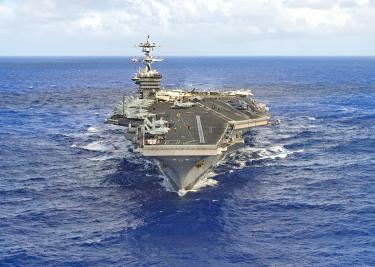The US Navy on Saturday said it had sent a carrier-led strike group to the Korean Peninsula in a show of force against North Korea’s “reckless” nuclear weapons program.
The move is expected to raise tensions in the region and comes hard on the heels of a US missile strike on Syria that was widely interpreted as putting Pyongyang on warning over its refusal to abandon its nuclear ambitions.
North Korea denounced Thursday’s strike as an act of “intolerable aggression” and one that justified “a million times over” the North’s push toward a credible nuclear deterrent.
“US Pacific Command ordered the Carl Vinson Strike Group north as a prudent measure to maintain readiness and presence in the Western Pacific,” said Commander Dave Benham, spokesman at US Pacific Command.
“The No. 1 threat in the region continues to be North Korea, due to its reckless, irresponsible and destabilizing program of missile tests and pursuit of a nuclear weapons capability,” he told reporters, in an unusually forceful statement.
Originally scheduled to make port calls in Australia, the strike group — which includes the Nimitz-class aircraft supercarrier USS Carl Vinson — is now headed from Singapore to the western Pacific Ocean.
Pyongyang is on a quest to develop a long-range missile capable of hitting the US mainland with a nuclear warhead, and has so far staged five nuclear tests, two of them last year.
Expert satellite imagery analysis suggests it could well be preparing for a sixth, with US intelligence officials warning that Pyongyang could be less than two years away from developing a nuclear warhead that could reach the continental US.
North Korea on Wednesday fired a medium-range ballistic missile into the Sea of Japan ahead of a US-China summit.
A nuclear-capable submarine-launched ballistic missile system would take the North’s threat to a new level, allowing deployment far beyond the Korean Peninsula and a “second-strike” capability in the event of an attack on its army bases.
The head of North American Aerospace Defense Command, which provides missile detection for the region, on Thursday said she was “extremely confident” of US capability to intercept a potential intercontinental ballistic missile (ICBM) bound for the US from North Korea.
However, General Lori Robinson expressed concerns over the type of ballistic missile powered by a solid-fuel engine that Pyongyang said it successfully tested in February.
“Amidst an unprecedented pace of North Korean strategic weapons testing, our ability to provide actionable warning continues to diminish,” Robinson said in written testimony to US senators.
In addition, while a US unilateral strike on North Korea from a shorter range might be more militarily effective, it likely would endanger many civilians in South Korea, experts said.
North Korea is barred under UN resolutions from any use of ballistic missile technology.
Source: Taipei Times - 2017/04/10





















